Page 239 of 558
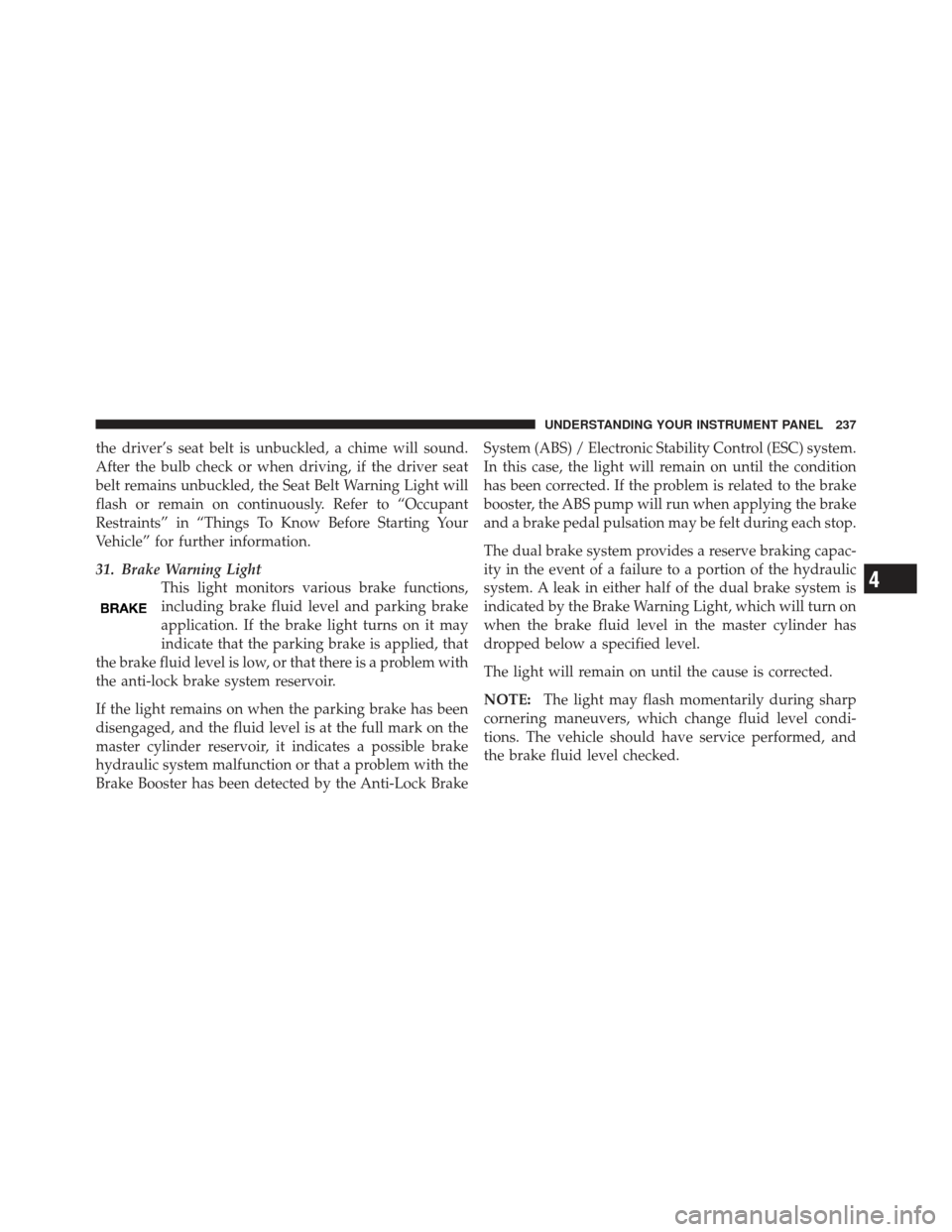
the driver’s seat belt is unbuckled, a chime will sound.
After the bulb check or when driving, if the driver seat
belt remains unbuckled, the Seat Belt Warning Light will
flash or remain on continuously. Refer to “Occupant
Restraints” in “Things To Know Before Starting Your
Vehicle” for further information.
31. Brake Warning LightThis light monitors various brake functions,
including brake fluid level and parking brake
application. If the brake light turns on it may
indicate that the parking brake is applied, that
the brake fluid level is low, or that there is a problem with
the anti-lock brake system reservoir.
If the light remains on when the parking brake has been
disengaged, and the fluid level is at the full mark on the
master cylinder reservoir, it indicates a possible brake
hydraulic system malfunction or that a problem with the
Brake Booster has been detected by the Anti-Lock Brake System (ABS) / Electronic Stability Control (ESC) system.
In this case, the light will remain on until the condition
has been corrected. If the problem is related to the brake
booster, the ABS pump will run when applying the brake
and a brake pedal pulsation may be felt during each stop.
The dual brake system provides a reserve braking capac-
ity in the event of a failure to a portion of the hydraulic
system. A leak in either half of the dual brake system is
indicated by the Brake Warning Light, which will turn on
when the brake fluid level in the master cylinder has
dropped below a specified level.
The light will remain on until the cause is corrected.
NOTE:
The light may flash momentarily during sharp
cornering maneuvers, which change fluid level condi-
tions. The vehicle should have service performed, and
the brake fluid level checked.
4
UNDERSTANDING YOUR INSTRUMENT PANEL 237
Page 240 of 558
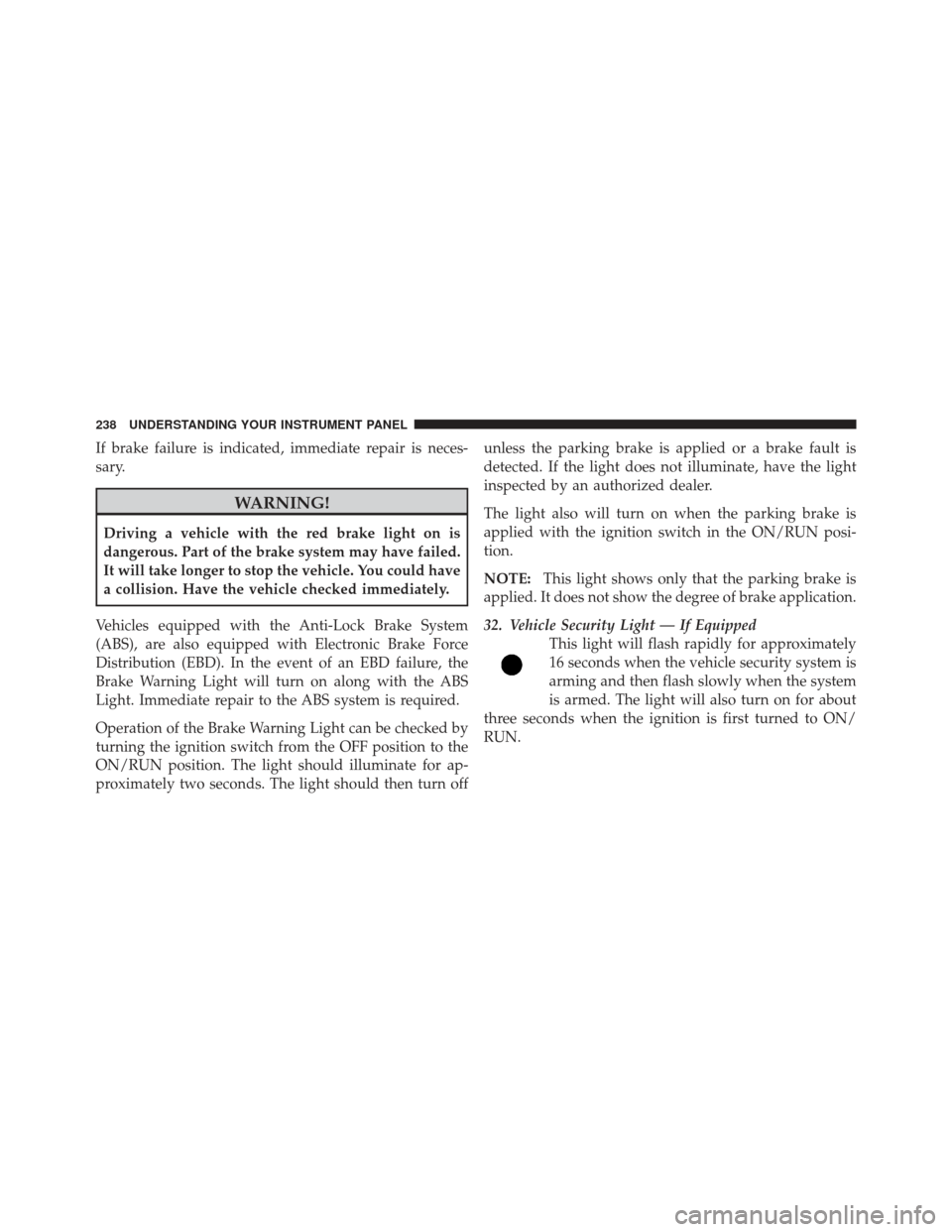
If brake failure is indicated, immediate repair is neces-
sary.
WARNING!
Driving a vehicle with the red brake light on is
dangerous. Part of the brake system may have failed.
It will take longer to stop the vehicle. You could have
a collision. Have the vehicle checked immediately.
Vehicles equipped with the Anti-Lock Brake System
(ABS), are also equipped with Electronic Brake Force
Distribution (EBD). In the event of an EBD failure, the
Brake Warning Light will turn on along with the ABS
Light. Immediate repair to the ABS system is required.
Operation of the Brake Warning Light can be checked by
turning the ignition switch from the OFF position to the
ON/RUN position. The light should illuminate for ap-
proximately two seconds. The light should then turn off unless the parking brake is applied or a brake fault is
detected. If the light does not illuminate, have the light
inspected by an authorized dealer.
The light also will turn on when the parking brake is
applied with the ignition switch in the ON/RUN posi-
tion.
NOTE:
This light shows only that the parking brake is
applied. It does not show the degree of brake application.
32. Vehicle Security Light — If Equipped This light will flash rapidly for approximately
16 seconds when the vehicle security system is
arming and then flash slowly when the system
is armed. The light will also turn on for about
three seconds when the ignition is first turned to ON/
RUN.
238 UNDERSTANDING YOUR INSTRUMENT PANEL
Page 255 of 558
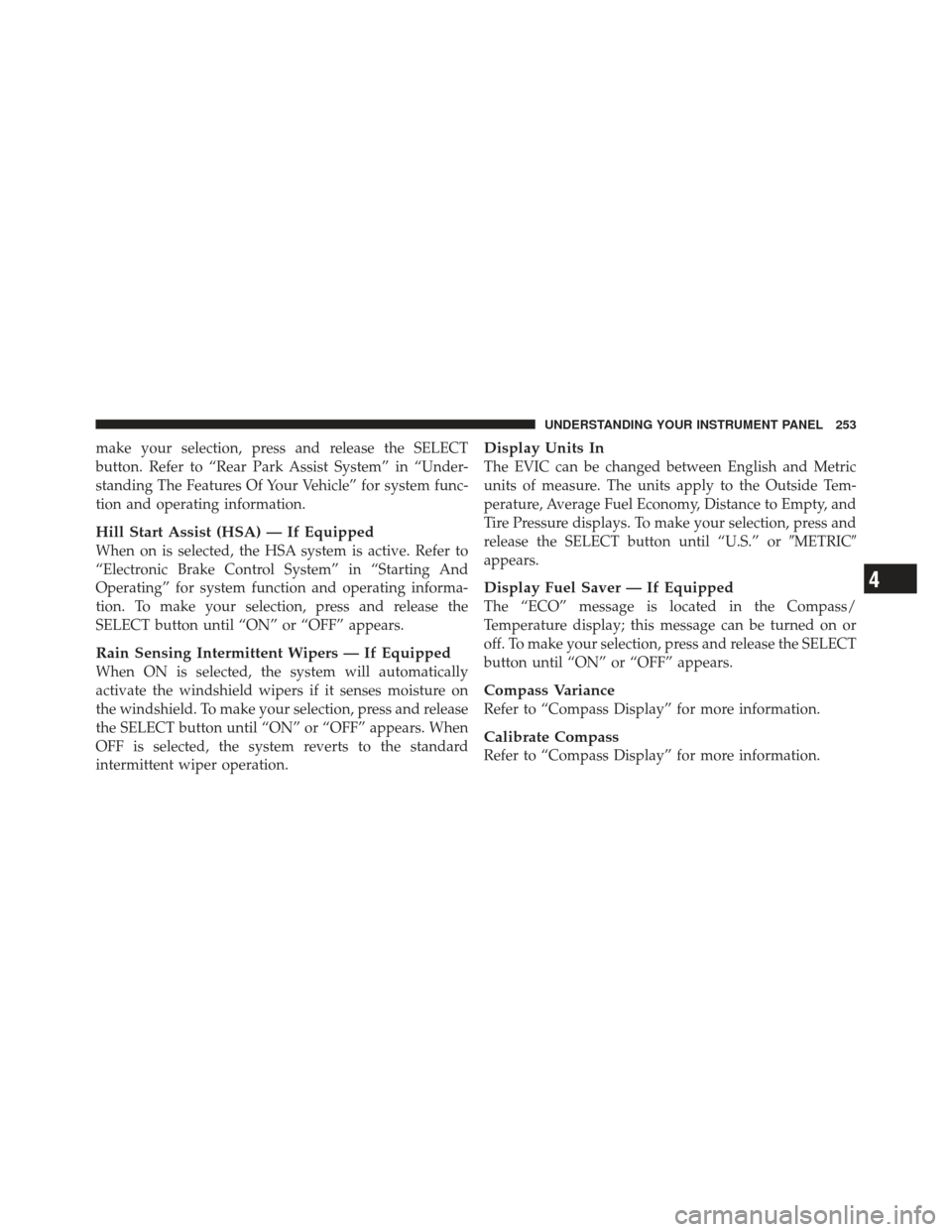
make your selection, press and release the SELECT
button. Refer to “Rear Park Assist System” in “Under-
standing The Features Of Your Vehicle” for system func-
tion and operating information.
Hill Start Assist (HSA) — If Equipped
When on is selected, the HSA system is active. Refer to
“Electronic Brake Control System” in “Starting And
Operating” for system function and operating informa-
tion. To make your selection, press and release the
SELECT button until “ON” or “OFF” appears.
Rain Sensing Intermittent Wipers — If Equipped
When ON is selected, the system will automatically
activate the windshield wipers if it senses moisture on
the windshield. To make your selection, press and release
the SELECT button until “ON” or “OFF” appears. When
OFF is selected, the system reverts to the standard
intermittent wiper operation.
Display Units In
The EVIC can be changed between English and Metric
units of measure. The units apply to the Outside Tem-
perature, Average Fuel Economy, Distance to Empty, and
Tire Pressure displays. To make your selection, press and
release the SELECT button until “U.S.” or�METRIC�
appears.
Display Fuel Saver — If Equipped
The “ECO” message is located in the Compass/
Temperature display; this message can be turned on or
off. To make your selection, press and release the SELECT
button until “ON” or “OFF” appears.
Compass Variance
Refer to “Compass Display” for more information.
Calibrate Compass
Refer to “Compass Display” for more information.
4
UNDERSTANDING YOUR INSTRUMENT PANEL 253
Page 317 of 558
STARTING AND OPERATING
CONTENTS
�Starting Procedures .................... 319
▫ Normal Starting ..................... 319
▫ Extreme Cold Weather
(Below –20°F Or –29°C) ................ 320
▫ If Engine Fails To Start ................ 320
▫ After Starting ....................... 321
� Engine Block Heater — If Equipped ........ 321
� Automatic Transmission ................. 322
▫ Key Ignition Park Interlock ............. 323▫
Brake/Transmission Shift Interlock System . . 323
▫ Four–Speed Automatic Transmission ....... 324
▫ Gear Ranges ........................ 324
� Four-Wheel Drive Operation ............. 333
▫ Command-Trac II� Transfer Case – If
Equipped .......................... 333
▫ Selec-Trac� II Transfer Case – If Equipped . . . 339
� On-Road Driving Tips .................. 344
5
Page 318 of 558
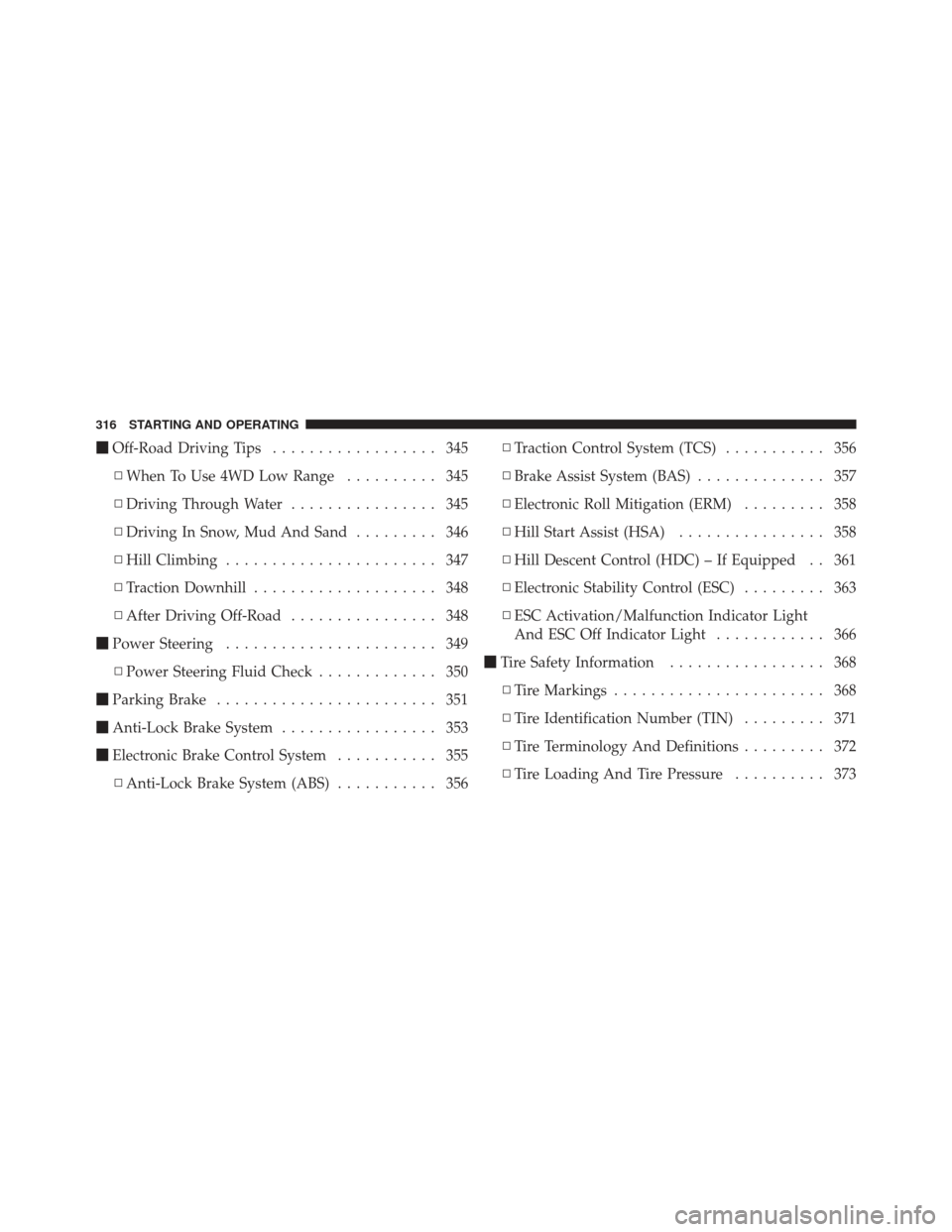
�Off-Road Driving Tips .................. 345
▫ When To Use 4WD Low Range .......... 345
▫ Driving Through Water ................ 345
▫ Driving In Snow, Mud And Sand ......... 346
▫ Hill Climbing ....................... 347
▫ Traction Downhill .................... 348
▫ After Driving Off-Road ................ 348
� Power Steering ....................... 349
▫ Power Steering Fluid Check ............. 350
� Parking Brake ........................ 351
� Anti-Lock Brake System ................. 353
� Electronic Brake Control System ........... 355
▫ Anti-Lock Brake System (ABS) ........... 356▫
Traction Control System (TCS) ........... 356
▫ Brake Assist System (BAS) .............. 357
▫ Electronic Roll Mitigation (ERM) ......... 358
▫ Hill Start Assist (HSA) ................ 358
▫ Hill Descent Control (HDC) – If Equipped . . 361
▫ Electronic Stability Control (ESC) ......... 363
▫ ESC Activation/Malfunction Indicator Light
And ESC Off Indicator Light ............ 366
� Tire Safety Information ................. 368
▫ Tire Markings ....................... 368
▫ Tire Identification Number (TIN) ......... 371
▫ Tire Terminology And Definitions ......... 372
▫ Tire Loading And Tire Pressure .......... 373
316 STARTING AND OPERATING
Page 321 of 558

STARTING PROCEDURES
Before starting your vehicle, adjust your seat, adjust both
inside and outside mirrors, and fasten your seat belts.
WARNING!
•When leaving the vehicle, always remove the key
fob from the ignition and lock your vehicle.
•Never leave children alone in a vehicle, or with
access to an unlocked vehicle. Allowing children
to be in a vehicle unattended is dangerous for a
number of reasons. A child or others could be
seriously or fatally injured. Children should be
warned not to touch the parking brake, brake
pedal or the shift lever.
•Do not leave the keys in the ignition. A child could
operate power windows, other controls, or move
the vehicle.(Continued)
WARNING! (Continued)
Never leave children alone in a vehicle. Leaving
children in a vehicle unattended is dangerous for a
number of reasons. A child or others could be seri-
ously or fatally injured. Do not leave the keys in the
ignition. A child could operate power windows,
other controls, or move the vehicle.
Start the engine with the shift lever in the NEUTRAL or
PARK position. Apply the brake before shifting to any
driving range.
Normal Starting
NOTE: Normal starting of either a cold or a warm
engine is obtained without pumping or pressing the
accelerator pedal.
5
STARTING AND OPERATING 319
Page 324 of 558
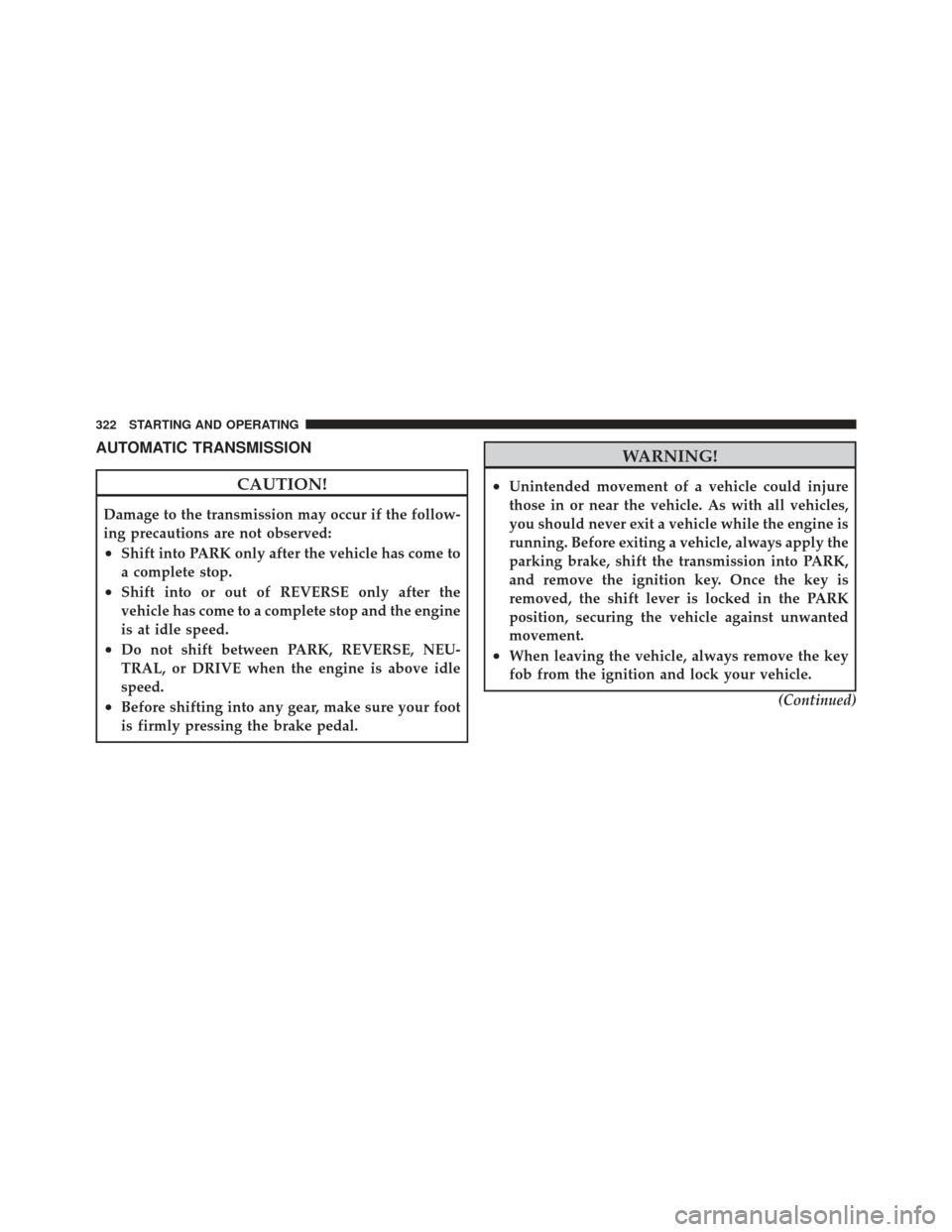
AUTOMATIC TRANSMISSION
CAUTION!
Damage to the transmission may occur if the follow-
ing precautions are not observed:
•Shift into PARK only after the vehicle has come to
a complete stop.
•Shift into or out of REVERSE only after the
vehicle has come to a complete stop and the engine
is at idle speed.
•Do not shift between PARK, REVERSE, NEU-
TRAL, or DRIVE when the engine is above idle
speed.
•Before shifting into any gear, make sure your foot
is firmly pressing the brake pedal.
WARNING!
•Unintended movement of a vehicle could injure
those in or near the vehicle. As with all vehicles,
you should never exit a vehicle while the engine is
running. Before exiting a vehicle, always apply the
parking brake, shift the transmission into PARK,
and remove the ignition key. Once the key is
removed, the shift lever is locked in the PARK
position, securing the vehicle against unwanted
movement.
•When leaving the vehicle, always remove the key
fob from the ignition and lock your vehicle.(Continued)
322 STARTING AND OPERATING
Page 325 of 558
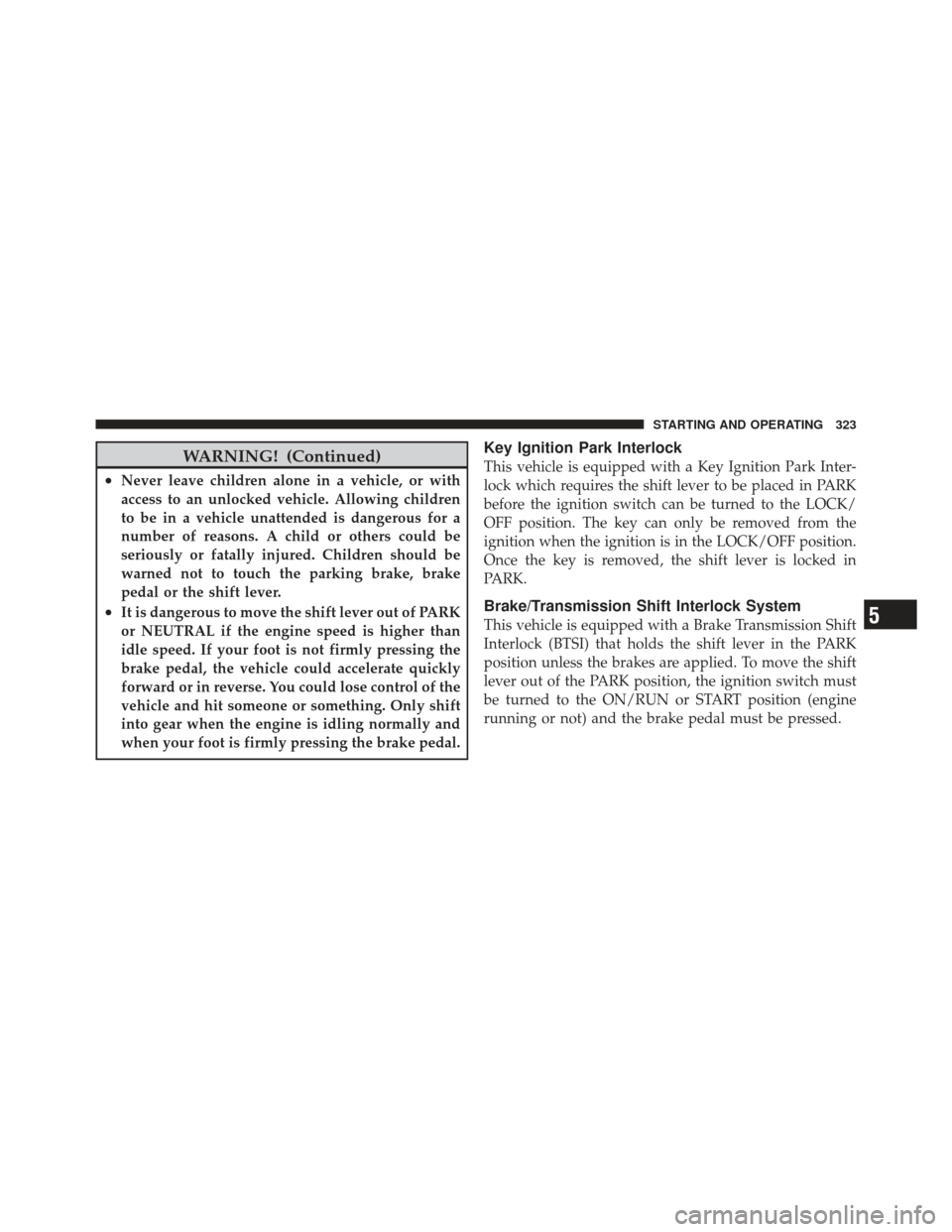
WARNING! (Continued)
•Never leave children alone in a vehicle, or with
access to an unlocked vehicle. Allowing children
to be in a vehicle unattended is dangerous for a
number of reasons. A child or others could be
seriously or fatally injured. Children should be
warned not to touch the parking brake, brake
pedal or the shift lever.
•It is dangerous to move the shift lever out of PARK
or NEUTRAL if the engine speed is higher than
idle speed. If your foot is not firmly pressing the
brake pedal, the vehicle could accelerate quickly
forward or in reverse. You could lose control of the
vehicle and hit someone or something. Only shift
into gear when the engine is idling normally and
when your foot is firmly pressing the brake pedal.
Key Ignition Park Interlock
This vehicle is equipped with a Key Ignition Park Inter-
lock which requires the shift lever to be placed in PARK
before the ignition switch can be turned to the LOCK/
OFF position. The key can only be removed from the
ignition when the ignition is in the LOCK/OFF position.
Once the key is removed, the shift lever is locked in
PARK.
Brake/Transmission Shift Interlock System
This vehicle is equipped with a Brake Transmission Shift
Interlock (BTSI) that holds the shift lever in the PARK
position unless the brakes are applied. To move the shift
lever out of the PARK position, the ignition switch must
be turned to the ON/RUN or START position (engine
running or not) and the brake pedal must be pressed.5
STARTING AND OPERATING 323